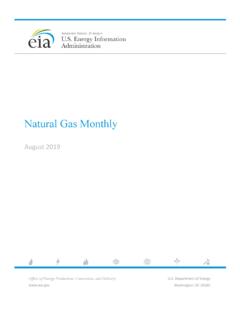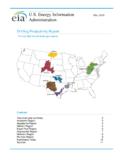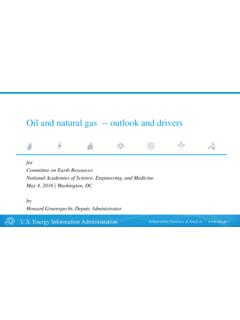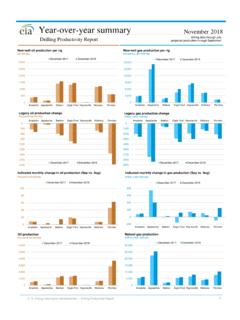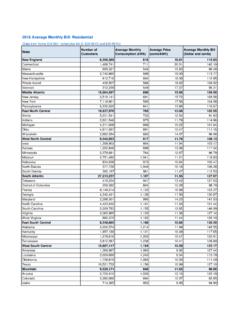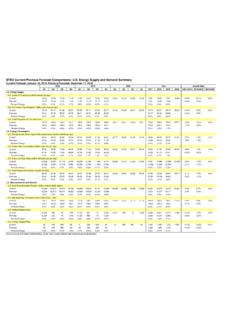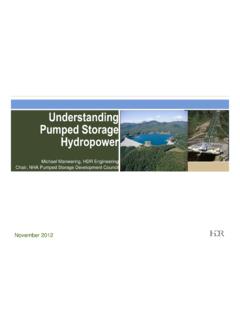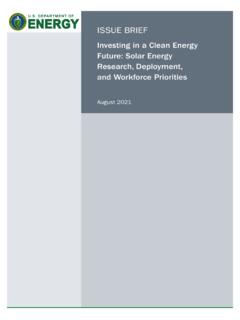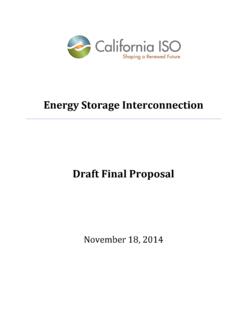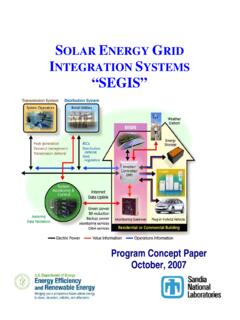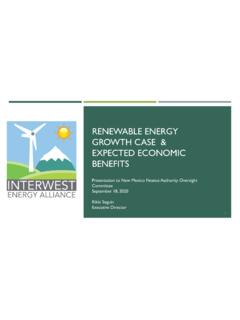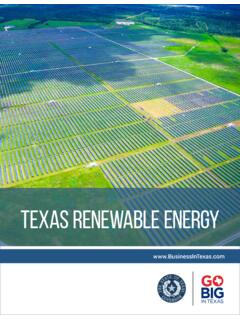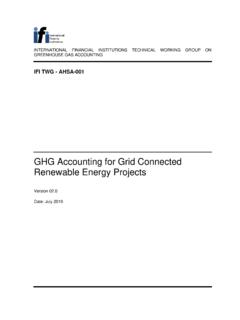Transcription of Battery Storage - Energy Information Administration
1 Battery Storage Market Trends May 2018. Independent Statistics & Analysis Department of Energy Washington, DC 20585. This report was prepared by the Energy Information Administration (EIA), the statistical and analytical agency within the Department of Energy . By law, EIA's data, analyses, and forecasts are independent of approval by any other officer or employee of the United States Government. The views in this report therefore should not be construed as representing those of the Department of Energy or other federal agencies. Energy Information Administration | US. Battery Storage Market Trends i Acknowledgements The authors of this report gratefully acknowledge the Energy Storage stakeholders in various public and private positions that participated in interviews with the Energy Information Administration staff.
2 Kevin Lynn, Jennifer Garson, Guohui Yuan ( Department of Energy ), Eric Dufek, Kurt Myers (Idaho National Laboratories), Paul Denholm (National Renewable Energy Laboratories), Babu Chalamala, Raymond Byrne, Tu Nguyen, David Copp (Sandia National Laboratories), Mary Wierzbicki, Michael Herbert (Federal Energy Regulatory Commission), Jill Powers, William Weaver, Andrew Ulmer, Eric Kim (California Independent System Operator), Rachel McMahon (California Public Utilities Commission), Michael DeSocio, David Flanagan, Raymond Stalter (New York Independent System Operator), Jason Doling, Benjamin Falber, Dana Nilsson, Jennifer Phelps (New York State Energy Research and Development Authority), Logan Goldie-Scot, Sam Cotterall (Bloomberg New Energy Finance), Ravi Manghani (Greentech Media), Haresh Kamath (Electric Power Research Institute), Sam Jaffe (Cairn Energy Research Advisors), Davion Hill (DNV-GL), Simkho Zirkiyev and Adrienne Lalle (Con Edison), Loic Gaillac (Southern California Edison), Kiran Kumaraswamy (Fluence), Ken Boyce (Underwriters Laboratories), Wufan Jia (Mobility House), Carly Sorrentino and Manal Yamout (Advanced Microgrid Solutions)
3 All provided helpful feedback and advice during the process of producing this report. Energy Information Administration | US. Battery Storage Market Trends ii List of Acronyms AEO Annual Energy Outlook AK/HI Alaska and Hawaii CAES Compressed-Air Energy Storage CAISO California Independent System Operator CPUC California Public Utility Commission DOE Department of Energy EIA Energy Information Administration ERCOT Electric Reliability Council of Texas FERC Federal Energy Regulatory Commission GW Gigawatt IOU Investment-owned utilities ITC Investment Tax Credit IPP Independent power producers ISO-NE Independent System Operator of New England KIUC Kauai Island Utility Cooperative kW Kilowatt kWh Kilowatthour MISO Mid-Continent Independent System Operator MW Megawatt MWh
4 Megawatthour PGE Pacific Gas and Electric PJM Pennsylvania-New Jersey-Maryland interconnection PPA Power purchase agreement SCE Southern California Edison SDGE San Diego Gas and Electric SGIP Self-Generation Incentive Program SMUD Sacramento Municipal Utility District Energy Information Administration | US. Battery Storage Market Trends iii Table of Contents ii List of Acronyms .. iii List of Figures .. v Executive 1. Introduction .. 3. Large-Scale Battery Storage Trends .. 4. Regional Trends .. 4. Ownership 7. Chemistry Trends .. 8. Chemistry Descriptions .. 8. Chemistry Trends .. 9. Current Applications .. 10. Application Descriptions .. 10. Applications by Region.
5 11. Battery Storage 12. Cost Background .. 12. Cost Results .. 13. Other Cost Metrics .. 14. Small-Scale Energy Storage Trends .. 15. Small-Scale Energy Storage Trends in California .. 15. Small-Scale Energy Storage Trends in the Rest of the United States .. 16. Market and Policy Drivers .. 17. Wholesale Market Rules .. 17. State-Level Policy Actions .. 17. Policy Actions in California .. 18. Policy Actions in the Rest of the United States .. 18. Future Trends .. 19. Appendix .. 21. Appendix A: Applications Additional Figures .. 22. Appendix B: Other Storage Technologies .. 25. Energy Information Administration | US. Battery Storage Market Trends iv List of Figures Figure 1.
6 Large-Scale Power and Energy Capacity by Region (2017).. 4. Figure 2. Large-Scale Battery Storage Installations by Region (2017) .. 5. Figure 3. Large-Scale Battery Storage Capacity by Region (2003 2017) .. 6. Figure 4. Power Capacity and Duration of Large-Scale Battery Storage by Region (2017) .. 7. Figure 5. Large-Scale Battery Storage Capacity by Region and Ownership Type (2016).. 7. Figure 6. Large-Scale Battery Storage Capacity by Chemistry (2003 2016) .. 9. Figure 7. Applications Served by Large-Scale Battery Storage (2016) .. 11. Figure 8. Total Installed Cost of Large-Scale Battery Storage Systems by Duration .. 13. Figure 9. Small-Scale Energy Storage Capacity by Sector (2016).
7 15. Figure 10. Small-Scale Energy Storage Capacity Outside of California by Sector (2016) .. 16. Figure 11. Large-Scale Wind, Solar, and Battery Storage Capacity Projections (2020 2050) .. 19. Figure 12. Applications Served by Large-Scale Battery Storage (2016) .. 22. Figure 13. Large-Scale Battery Storage Capacity and Applications Served (2016) .. 23. Figure 14. Large-Scale Battery Storage Capacity and Applications Served (2016) .. 24. Figure 15. Hydroelectric Pumped Storage Capacity (1960 2017).. 25. Energy Information Administration | US. Battery Storage Market Trends v May 2018. Executive Summary This report explores trends in Battery Storage capacity additions and describes the current state of the market, including Information on applications, cost, and market and policy drivers.
8 There are a number of key takeaways: At the end of 2017, 708 megawatts (MW) of power capacity, 1 representing 867 megawatthours (MWh) of Energy capacity, 2 of large-scale 3 Battery Storage capacity was in operation. Over 80% of large-scale Battery Storage power capacity is currently provided by batteries based on lithium-ion chemistries. About 90% of large-scale Battery Storage in the United States is installed in regions covered by five of the seven organized independent system operators (ISOs) or regional transmission organizations (RTOs) and in Alaska and Hawaii (AK/HI). Figure ES1. Large-Scale Battery Storage Capacity by Region (2003 2017). power capacity Energy capacity megawatts megawatthours annual additions cumulative capacity annual additions cumulative capacity 300 900 300 900.
9 Other Other AK/HI AK/HI. 250 ISO-NE 750 250 ISO-NE 750. MISO MISO. 200 ERCOT 600 200 ERCOT 600. CAISO CAISO. 150 PJM 450 150 PJM 450. 100 300 100 300. 50 150 50 150. 0 0 0 0. 2003 2005 2007 2009 2011 2013 2015 2017 2003 2005 2007 2009 2011 2013 2015 2017. Notes: 2017 Energy capacity data for large-scale Battery Storage are based on preliminary estimates; Energy capacity annual additions do not include 26 MW of since-retired batteries because Energy capacity is not reported for retired generators Sources: Energy Information Administration , Form EIA-860M, Preliminary Monthly Electric Generator Inventory; Energy Information Administration , Form EIA-860, Annual Electric Generator Report.
10 Nearly 40% of existing large-scale Battery Storage power capacity (and 31% of Energy capacity). lies in the Pennsylvania-New Jersey-Maryland interconnection (PJM), which runs Energy and capacity markets and the transmission grid in 13 eastern states and the District of Columbia. o In 2012, PJM created a new frequency regulation market product for fast-responding resources, the conditions of which were favorable for Battery Storage . However, recent changes in PJM's market rules have slowed Battery installations in the region. o Most existing large-scale Battery Storage power capacity in PJM is owned by independent power producers providing power-oriented frequency regulation services.

